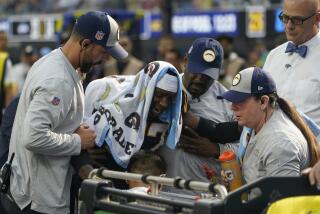He Passes Test Easily
- Share via
KIRKLAND, Wash. — A pencil. A piece of paper. Abstract designs.
Those could be the keys to the NFC championship game.
Because those are what NFL MVP Shaun Alexander used to get clearances from doctors to play against the Carolina Panthers today -- just eight days after he sustained a concussion in Seattle’s win over Washington.
“I am feeling blessed,” the league’s leading rusher said. “I didn’t think that I would be able to heal that fast.”
Alexander didn’t have to have wires strapped to his head, like a modern-day Frankenstein, to pass a four-day battery of tests through Tuesday that convinced the Seahawks’ medical staff he was ready to return.
Those doctors also didn’t use the results of CT brain scans or MRIs to decide Alexander was OK to get hit by the Panthers -- though those tests assured doctors he had no further, potentially critical head injuries.
Instead, Alexander went to school. Old school.
No computers. No televisions. Just a desk and his slab of wood-wrapped lead, which he used to scribble lists of words in a test of his short-term memory. He viewed abstract designs to test comprehension. He filled in symbols as quickly as he could to test his mental speed.
It’s simply called the “paper-and-pencil” test. Most NFL teams have adopted it to assess concussions since the Pittsburgh Steelers first started using it in 1994, after it was developed across town at the University of Pittsburgh Medical Center.
“I think in this day and age we’re being more careful with that type of injury. And that’s the right thing to do,” said Seahawks coach Mike Holmgren, who estimates he has had six players with concussions of varying degrees over his 14 years as an NFL head coach.
The Seahawks were one of the first NFL teams to adopt standardized concussion assessments, one year after the Steelers did.
Alexander was also playing the right sport to be able to come back so quickly.
If Alexander was a boxer in Washington state, he’d be unable to compete for at least 60 days after a concussion, and likely indefinitely beyond that, said Randy Renfrow of the state’s professional athletics licensing program.
If he was hurt in Nevada, the center of U.S. professional boxing, he’d also likely be out for at least 60 days, said Marc Ratner, executive director of the Nevada State Athletic Commission.
When asked Thursday if he had ever heard of a boxer in his state returning in a week, Ratner said, “Not after a concussion, no.”
That leaves the appearance Alexander might be rushing back too soon. Is boxing, of all sports, more prudent and thoughtful than the NFL?
Not so, said Dr. Mark Lovell of the University of Pittsburgh, who is also the NFL’s director of neuropsychological testing and the developer of the “paper-and-pencil test.”
“Actually, the NFL is probably more standardized than boxing on concussion management,” Lovell said Thursday from his office, which is next to the Steelers’ practice facility on Pittsburgh’s south side. “We developed testing protocols for the league, rather than using, ‘He looks OK to me.”’
Lovell, who also does concussion testing and studies for NASCAR and the NHL, said he is trying to get boxing to adopt the testing the NFL uses.
Seahawks team physician Stan Herring is a rehabilitation doctor by trade, Lovell said, so “he is more trained in brain rehabilitation than most guys” on NFL team medical staffs.
That means Seattle is more likely than most teams to test each player before a given season for baseline data on normal brain functioning. In this case, that would have given the Seahawks Alexander’s normal reaction times and other results. Once he approached those results this week, they could clear him to play.
More to Read
Go beyond the scoreboard
Get the latest on L.A.'s teams in the daily Sports Report newsletter.
You may occasionally receive promotional content from the Los Angeles Times.










